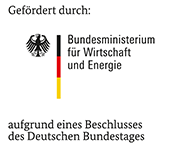302 ZBG

| Period: | 01.01.2009 - 30.12.2011 |
|---|---|
| Partner: | Frauenhofer IKTS |
| Funder: | AiF |
| Project Manager: | Dr. Britta Tigges |
| Research Group: | Corrosion |
Aims
Plasma-chemical oxidation procedures and hard anodizing are established methods for simultaneous wear and corrosion protection of aluminium materials. Both methods have significant disadvantages that confine the attractiveness for industrial application. First of all, the energy input is extremely high for both methods because of the required high voltages. Additionally extensive technical equipment is required, e. g. for cooling of the baths during hard anodizing due to high heat input. Therefore, the aim of the project is the development of an alternative procedure based on the classic hard anodizing, which should lead to oxidic layers with wear-resistant and corrosion protective properties at a lower energy input. For this the current-voltage regime is to be changed in terms of pulse anodizing in sulphuric acid. By a simultaneous incorporation of oxidic, wear-resistant nanoparticles and inhibitors embedded into nanocapsules during anodizing a wear and corrosion protection should be reached also for thinner layers. The new procedure will be developed by cooperation between two complementary research institutes (Fraunhofer IKTS and Karl-Winnacker-Institute of DECHEMA). Fraunhofer IKTS should mainly focus on the modification of the anodizing process, whereas our Institute will concentrate on the development of the nanotechnological methods. The results will finally be combined to lead to a new one-step anodizing process.
Results
Electrophoretic deposition of silica nanoparticles on aluminium samples (AA 1050) at alkaline pH values and at low conductivities was performed at voltages of 2 V and 30 V. SEM investigation shows that the amount deposited on the aluminium sample is significantly higher for the low voltage. This is most probably due to the gas evolution at the electrodes because of water electrolysis that becomes more vigorous for higher voltages. For modulated voltages (changing between 2 V and 30 V) the amount of SiO2 is lower than for the low voltage experiment but higher than for the high voltage experiment. Increasing the conductivity of the dispersions by addition of Na2SO4 leads to a reduction of the deposited amount of SiO2. This corroborates former publications about electrophoretic deposition stating that a high conductivity is disadvantageous for the deposition process.
For electrophoretic deposition on the aluminium anode at pH 0 a surface modification of the nanoparticles is necessary. The reason for this is the surface protonation and consequently the change of zeta potential from negative to positive values by addition of sulfuric acid. For surface modification the strong polyelectrolyte sodium-polystyrene sulphonate (PSS) was chosen. This polyelectrolyte is still negatively charged at pH 0 and adsorbs electrostatically on the positively charged particle surface. By modification with PSS a negative zeta potential can be re-established for SiO2-nanoparticles as well as for boron carbide nanoparticles. Dynamic light scattering measurements show no significant changes in size distribution of the particles after addition of sulfuric acid or modification with PSS.
Additionally, mesoporous SiO2-nanoparticles were prepared which are planned to be used as nanocontainers for corrosion inhibitors. The synthesis is done by hydrolysis of tetraethylorthosilicate in a mixture of ethanol, water and a surfactant. Particle diameters of 80 nm and 300 nm were prepared. The surface area of these nanoparticles determined by N2-adsorption is approx. 500 - 1000 m2/g.
Anodising of aluminium samples (AA1050) in sulfuric acid at pH 0 was done at 5 °C because lower temperatures can lead to agglomeration of the nanoparticles in the anodising solution. The slope of the voltage was adjusted in a way that allows for a fast increase to 20 V and a slower increase to 30 V. Under these conditions no incorporation of nanoparticles into the anodising layer was observed. Hence, the modulated voltage described before (changing between 2 V and 30 V) was applied during the anodising process. The thickness of the as-prepared layers is approx. 0.5 µm - 2 µm. By electron micro probe investigation of a metallographic cross section of the anodising layers a Si-content of approx. 15 at-% in the upper part of the layer could be determined. Compared to layers without nanoparticles the layers containing nanoparticles have a rough and uneven appearance. In summary it can be concluded that most probably the incorporation of nanoparticles in anodising layers on aluminium was successful.
back

Das IGF-Vorhaben Nr. 302 ZBG der Forschungsvereinigung DECHEMA e.V., Theodor-Heuss-Allee 25, 60486 Frankfurt am Main wurde über die AiF im Rahmen des Programms zur Förderung der industriellen Gemeinschaftsforschung (IGF) vom Bundesministerium für Wirtschaft und Energie aufgrund eines Beschlusses des Deutschen Bundestages gefördert.
Contact |
| Prof. Dr.-Ing. Wolfram Fürbeth |
| Tel.: 069 / 75 64-398 E-mail: fuerbeth |
Publications |
| Final Report (ca. 7 MB) |